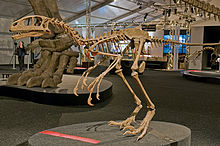Unenlagia
| Unenlagia | ||||||||||||
|---|---|---|---|---|---|---|---|---|---|---|---|---|

Live reconstruction of Unenlagia |
||||||||||||
| Temporal occurrence | ||||||||||||
| Upper Cretaceous ( Turonium to Coniacium ) | ||||||||||||
| 93.9 to 86.3 million years | ||||||||||||
| Locations | ||||||||||||
| Systematics | ||||||||||||
|
||||||||||||
| Scientific name | ||||||||||||
| Unenlagia | ||||||||||||
| Novas & Puerta , 1997 |
Unenlagia is a genus of theropod dinosaur from the group of Dromaeosauridae . Finds of this animal come from the Upper Cretaceous ( Turonium to Coniacium ) in the Argentine province of Neuquén .
So far, two species of this genus have been described: The type species Unenlagia comahuensis was scientifically described in 1997 and is based on a fragmentary skeleton without a skull. A few bones were described as the second species, Unenlagia paynemili , in 2004 .
As a likely feathered dinosaur , Unenlagia has a lot in common with birds, which is why it was originally proposed as a possible sister taxon of this group. Norell and Makovicky (1999), however, showed many similarities between this genus and dromaeosaurids. Today Unenlagia is mostly classified within an original dromaeosaurid group limited to the southern continents , the Unenlagiine.
Makovicky and colleagues (2005) suspect that the genus Neuquenraptor was identical to Unenlagia - this assumption is supported by several other authors.
features
Unenlagia was a medium-sized dromaeosaurid - the holotype specimen is estimated to be about 2 meters long, the weight calculated a study at 105.7 kg. The length of the femur (thigh bone) of the holotype specimen, an important size for length comparisons, was about 38 cm.
Unenlagia resembles the ancient bird Archeopteryx in the shape of the shoulder blade, pelvis and hind legs . As with birds, the arm bones show the modifications necessary for folding the wings as well as for a powerful wing beat, although Unenlagia was probably too big to fly. Unlike birds, however, several primitive characteristics were pubic bone (pubis) and the ischium (ischium) and the proportions of the hind limb bones.
With Unenlagia paynemili , Jorge Calvo and colleagues (2004) described a second species that shares the lower end of the pubic bone, which is oriented towards the rear, with the type species Unenlagia comahuensis as a common feature ( synapomorphism ). Another possible synapomorphism is the curved dorsal edge of the post-acetabular iliac bone (ilium). In contrast to Unenlagia comahuensis , however , Unenlagia paynemili had more delicate bones, a smaller angle between the lower edge of the deltopectoral ridge and the humerus shaft on the humerus , a small process on the anterior side of the lower end of the pubic bone, and a wider and more rounded distal end of the post-acetabular one Ilium.
Find and naming
The first find, the holotype specimen of Unenlagia comahuensis (specimen number MCF PVPH 78), comes from the Portezuelo Formation (late Turonian to early Coniacian), a member of the Río-Neuquen subgroup. It consists of the eighth, tenth and thirteenth vertebrae, three dorsal ribs, the sacrum , two chevron bones , shoulder blade (scapula), humerus (27 cm), iliac, pubic bone, ischium, femur and shin (43.1 cm).
Further material was discovered in 2002 by a research team in Futalognko , an important site for vertebrate fossils 90 km northwest of the city of Neuquén . The isolated remains discovered include the left humerus and left pubic bone, both bones likely belonging to the same individual. These bones form the holotype of Unenlagia paynemili and are listed under the specimen number MUCPv-349. Further material from the same site that is ascribed to this species is a dorsal vertebra (MUCPv-416) and the rear end of the right iliac bone (MUCPv-409) discovered in 2003. For the time being, an isolated phalanx (Phalange, MUCPv-415) and a claw (Ungual, MUCPv-343) from Futalognko Unenlagia paynemili are ascribed.
Unenlagia comahuensis was described by Novas and Puerta in 1997 . The name Unenlagia comes from the Mapuche language and means "half bird" ( uñen - "half" and lay - "bird"). The epithet of the second species paynemili , described in 2004, honors Maximino Paynemil, the head of an Indian community who lives in the region of the Futalognko site.
swell
- Jorge O. Calvo , Juan D. Porfiri, Alexander W. Kellner: On a new maniraptoran dinosaur (Theropoda) from the Upper Cretaceous of Neuquén, Patagonia, Argentina. In: Arquivos do Museu Nacional. Rio de Janeiro. Vol. 62, No. 4, 2004, ISSN 0365-4508 , pp. 549-566, digital version (PDF; 12.2 MB) .
Web links
Individual evidence
- ↑ a b c Alan H. Turner, Diego Pol, Julia A. Clarke, Gregory M. Erickson, Mark A. Norell : A Basal Dromaeosaurid and Size Evolution Preceding Avian Flight. In: Science . Vol. 317, No. 5843, 2007, pp. 1378-1381, doi : 10.1126 / science.1144066 , digitized version (PDF; 507.41 KB) , Supporting Online Material (PDF; 755.11 KB) .
- ^ Peter J. Makovicky , Sebastián Apesteguía, Federico L. Agnolín: The earliest dromaeosaurid theropod from South America. In: Nature . Vol. 437, No. 7061, 2005, pp. 1007-1011, doi : 10.1038 / nature03996 .
- ↑ Fernando E. Novas , Pablo F. Puertat: New evidence concerning avian origins from the Late Cretaceous of Patagonia. In: Nature. Vol. 387, No. 6631, 1997, pp. 390-392, doi : 10.1038 / 387390a0 .
- ↑ Michael Mortimer: Dromaeosauridae. In: The Theropod Database. Archived from the original on October 3, 2011 ; accessed on July 31, 2014 .
- ↑ Ben Creisler: Dinosauria Translation and Pronunciation Guide. In: The Theropod Database. Archived from the original on November 10, 2011 ; accessed on July 31, 2014 .

